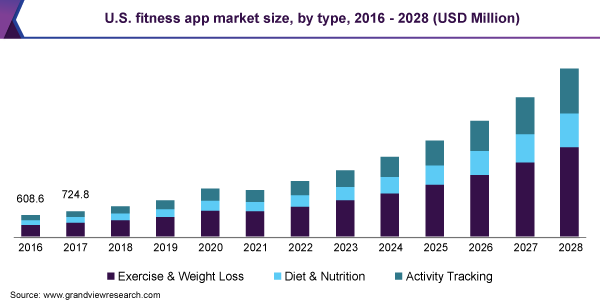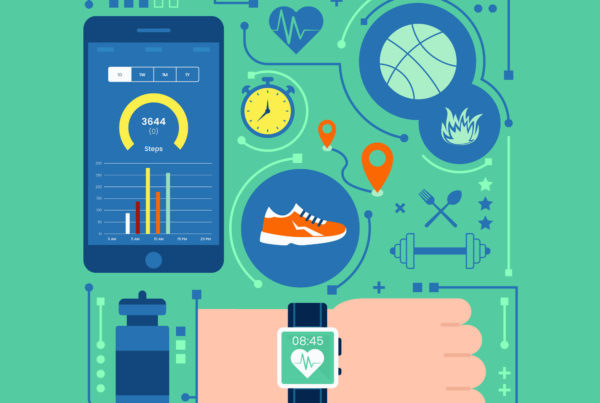Introduction
The worldwide fitness app market size, which was valued at USD 4.4 billion in 2021, is now expected to show an uprising trend at CAGR 21.6% from 2021 to 2028. The transition to the virtual fitness world has contributed majorly to the increased number of downloads and usage since the onset of pandemic Covid-19. Growth in health and wellness awareness is another factor driving this growth of fitness mobile app development.

This read will guide you through the cost and the factors that drive the cost of building a fitness mobile application. So let’s begin;
How much does it cost to make a fitness mobile application?
There is no single numerical value that can answer this question. Therefore, we will furnish you with factors that will help you calculate the estimated value of app development.
1. Features
Features are the accessories of your fitness app. Better features add more value to mobile applications. Although every category of fitness app has its own set of features, certain basic characteristics are common to all the existing fitness apps. The cost of adding these features to the apps depends on the time taken to develop them. And the time of developing each feature depends on its complexity. For example, the average time in developing the registration and login feature is 29 hours, fitness routing tracking is 40-78 hours, and so on.
2. Platform
Whether you are opting for web, Android or iOS platform is also one of the factor that determines the overall cost of the fitness mobile app development. The programming language on these platforms differs and so does their cost. As expected, the cost of mobile app development for the web is the least and that for iOS is the maximum. However, there are certain mobile app development agencies who provide cross platform solutions for Android and iOS, thus saving 50% of the overall cost.
3. Design
For a visually appealing and user friendly UI/UX design, you have to spare extra time and money too. The app users prefer intuitive apps, and so one needs to meet their demand at the end of the day. THe average time required for designing across iOS and Android platform is approximately 120 hours. When you want the application for both Android and iOS, then the UI/UX design on one gets adapted to another at 50% less time. Thus saving on cost too.
4. Testing
One can not take the risk to proceed further before performing the quality test. Quality assurance engineers perform the testing for identifying any bugs in the app and then providing the solution. If the project is complex, higher is the cost of testing and so on. The average time taken for testing a very basic fitness application is 530 hours.
5. Team location
Yes, the geographical location of the developers is also an essential determinant of the overall fitness application cost. The developers from Australia and America are the most expensive one, whereas from Ukraine are the most affordable ones. Therefore, if you plan to outsource the service from mobile fitness app developer, check their location before getting the deal done.
6. DevOps
DevOps services are needed to fill in the gap between IT operations and developers’ team. These services reduce the overall development time. The DevOps specialists have the right tools to automate the code flow from the point of development to production. The entire step takes approximately 100 hours.
7. Tech stack
For fitness mobile app development, one requires a scalable tech stack. There are two exclusive programming languages used by developers for developing Android and iOS apps — Kotlin and Swift, respectively. The choice of the tech stack impacts the fitness app cost. For a rarely used technology, the rates are rocket high, because of the lack of specialists in the market.
What is the need for developing a MVP for fitness application?
MVP or minimum value product can also be referred to as the minimum functionality product. Good developers who are more focused on the value they offer to the client rather than making big bucks profit will always suggest that you go for an MVP first. The MVP approach focuses only on the essentials. It helps to save on your time, efforts and investment. This also means that it gives an estimate of the minimum cost required to design the fitness application with all the essential features incorporated. This approach is helpful as it:
Helps you reduce the cost which you might have incurred irrationally.
Time to market the product is also reduced.
You get early bird users of your fitness app. The feedback of these users further helps to refine and redefine the application.
Wrapping up!
In this read, we have shared a lot about the cost of developing the fitness mobile application and also shared few tips to keep the app economical. But before you invest in the fitness mobile app development, our piece of advice to you is first you study your competitors, clearly define the target audience and study the needs and preference of your audience. All this will provide you a better view of what all functions are as a mandate for your fitness app. Thereafter, begin with an MVP. Still, if you want to know more, we will be happy to answer your queries.
Also, we would appreciate your virtual tour across our plethora of digital services specially crafted for the fitness industry, you can contact us






